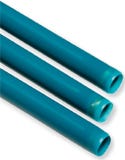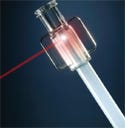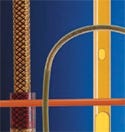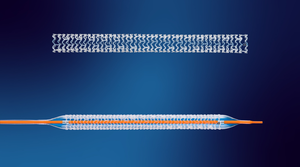Tubing and Tube Processing 15622
Wireless data collected directly from patients during normal physical activities could enable the development of better knee implants
January 6, 2008
Originally Published MPMN January/February 2008
SPOTLIGHT
Tubing and Tube Processing
Converted tubing
|
A company converts tubing into catheter-based delivery systems. Custom-designed delivery systems can be developed for a range of capabilities. Standard braid, variable pitch, and coil reinforcement design capabilities, as well as application-specific design services, are offered. Delivery system designs can include bonded tips, embedded marker bands, and insert molding. Tubing can be converted into delivery systems for applications such as TAA graft delivery and carotid and coronary stent delivery.
Teleflex Medical OEM, Kenosha, WI
www.teleflexmedicaloem.com
Puncture-resistant medical hose
|
Wire-free hose for medical applications is crush, pull, and puncture resistant. The Type 252 hose is designed to immediately return to its original shape if stretched or crushed. Its smooth interior improves flow characteristics and enables quiet performance. Lightweight and flexible, the tubing is also available with injection-molded cuffs.
Hi-Tech Medical, Georgetown, MA
www.hitechmedical.net
Laser-weldable tubing
|
Medical tubing features an additive technology that enables it to be laser welded to transparent medical components used in applications such as intravenous therapy, hemodialysis, and catheterization. The Clearweld additive eliminates the need for solvent or adhesive bonding, which can leave behind residual bonding material. The ability to laser weld can also improve processing efficiency. Sure Bond tubing is composed of Natvar 252 trilayer coextruded tubing for the delivery of unstable medications. It has an inner layer of polyethylene to prevent absorption and a proprietary middle layer for adhesion. An outer layer of Eastman Ecdel elastomer ensures that the tubing maintains its clarity, joint stability, and weld strength. It can withstand EtO and gamma sterilization.
Natvar, a Tekni-Plex company, Clayton, NC
www.natvar.com
Thermoset plastic tubing
|
Thermoset plastic tubing is manufactured with tighter tolerances than conventionally extruded tubing using a proprietary process, according to the manufacturer. Flexible and kink resistant, the polyimide tubing is intended for use in applications requiring maneuverability within small profiles, including neurological and fiber-optic devices, intravascular drug delivery, and balloon angioplasty. The sterilizable tubing is chemically inert, smooth, and transparent. A selection of colors is available.
MicroLumen Inc., Tampa, FL
www.microlumen.com
Three-layer extrusion head
|
Designed for three-layer extrusion, an extrusion head can be easily converted for single- and dual-layer applications with multiple striping options. The Tri-Die Crosshead can be used to produce a range of products that include microbore medical tubing, with minimum diameters of 0.015 in. It also provides die centering from the front and uses spiral helicoids with all-melt flow channels designed to maintain balanced flow throughout operation. Helicoids with multi- and spiral-channel designs are also used.
Genca, St. Petersburg, FL
www.genca.com
Tube-processing systems
|
Tube-processing systems are used to apply high-precision heat during bonding applications for a variety of catheter systems. The bonding systems feature the Thinline thermal nozzle, which provides uniform heating characteristics. The thermal nozzle also minimizes the occurrence of hot or cold spots during the shrinking process more than flat or C nozzles, according to the manufacturer. Semiautomatic processing capabilities include multilumen welds, braided-to-nonbraided butt welds, and braided-to-braided butt welds. The equipment can also handle balloon-to-shaft bonding and balloon-to-distal or proximal tip bonding.
Machine Solutions Inc., Flagstaff, AZ
www.machinesolutions.com
Composite tubing
|
Thin-walled composite tubing is made out of continuous fiberglass filaments. Polymed tubing has a high strength-to-weight ratio, is lightweight, sterilizable, and can maintain precise tolerances. The tubing also features radiolucent and dielectric properties. Applications include endoscopic or laparoscopic procedures that require devices to be electromagnetically transparent or to provide radiolucency. Composite tubing can also be used in suction and irrigation devices, electrosurgical devices, and catheters and needle sheaths.
Polygon Co., Walkerton, IN
www.polygoncompany.com
Extrusion head for tiny tubing
|
A supplier of extrusion tooling offers an extrusion head capable of producing tubing finer than a strand of human hair. The MediFlow system head and in-line dies are engineered for applications with minimum tolerances of 0.002 in. and other applications requiring tiny tubing, such as minimally invasive arthroscopic surgical procedures. A patented face spiral design enables the production of close-tolerance, thin-wall, multilayer tubing. The passage flow in the body can have a split flow or the manufacturer’s single-flow feed. If a tip is damaged or bent, the head’s two adjustable hypotube tip styles can be fixed by replacing an insert, which can take only a minute, rather than an entire tip. A single-component tip is also available.
Guill Tool & Engineering, Warwick, RI
www.guill.com
Copyright ©2008 Medical Product Manufacturing News
You May Also Like










